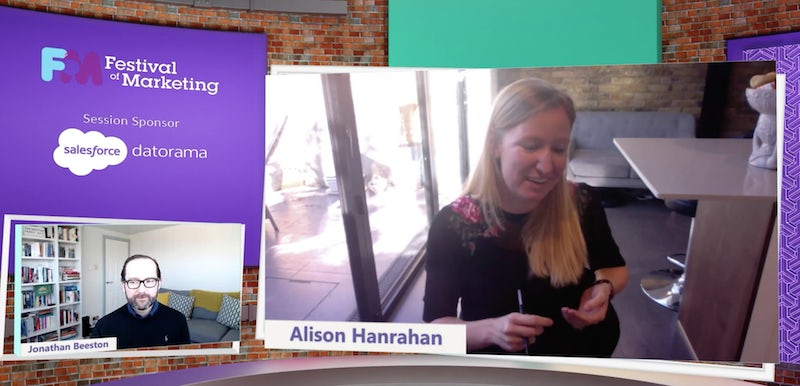
At the Festival of Marketing, Alison Hanrahan, Head of Marketing Performance and Enablement at HSBC was in conversation with Jonathan Beeston, EMEA Product Marketing Director at Salesforce.
Beeston put the challenges for marketers working with data into context by sharing some findings from Salesforce Datorama’s recent Marketing Intelligence Report, a survey of 1,000 marketers globally on data and analytics practices.
Some highlights from the survey include:
- Respondents on average said they use 21 different marketing or advertising platforms for cross-channel marketing.
- Three quarters of respondents said they spend either ‘a few days a month’ (45%) or ‘one week a month’ (30%) manually collecting, cleansing and harmonising data sets.
- Only one quarter of respondents say they have managed to fully automate the integration and harmonisation of cross-channel data.
- Only 21% of respondents were completely satisfied with their ability to leverage data for customer journey analytics.
Given that the survey revealed the top two growth-related business initiatives for the next 24 months to be a ‘connected customer experience’ and ‘ecommerce growth’ (both data-heavy projects), it’s clear why challenges such as data veracity and variety, connecting data, and sharing it with different stakeholders are so crucial right now.
HSBC’s Hanrahan admitted the findings in the report resonated with her, saying “two of our biggest data challenges at HSBC are around data quality and connecting up that data… to actually make it usable.”
She was, however, keen to add a note of realism, adding that “as much as this [survey] really highlights that there’s a long way to go in marketing in the use of data, I also hope that it inspires people a little bit because… you often hear this perception that so many others have cracked this…. and that’s really not the case. [Only a] minority of marketers have gotten this really right.”
As marketers we have to be careful not to settle for campaign metrics.”
Hanrahan was asked about connecting marketing activity, and the data that comes with it, through to real business outcomes that are meaningful to stakeholders and to the board.
“As marketers we have to be careful not to settle for campaign metrics,” she said. “And we have to push for those business outcomes.”
“Once we have established those business outcomes,” Hanrahan added, “marketers need to understand the wider context of those in terms of the strategy for the organisation. So, ‘Is this a one-off initiative? Is it a core part of the strategy? How does it fit into that wider context?’
Central to this pursuit of business outcomes, according to Hanrahan, is “the importance of a single source of data,” often called “a marketing golden source or a strategic marketing data store.”
we have to make sure we’re working with a common set of facts across the business”
“To connect to those business outcomes, we have to make sure we’re working from a common set of facts across the business. In order to do that, we need to be getting our marketing data into these strategic data stores for the business…[and] developing a ‘360 view’ of the customer.”
“In order to get there,” said Hanrahan, “one of the activities that we’ve done at HSBC that I think has really helped is mapping those end-to-end journeys, so when we’re doing a marketing programme, [we understand] where it fits in in that journey. Not just the sales touchpoints or the customer touchpoints, but understanding what data is required for that [marketing] activity and what data is then produced, and making sure the data lifecycle is fully cyclical and informing increased data quality and [then] providing marketers access to that data.”
lean in to those conversations, address the data quality issues”
Hanrahan addressed trust in data directly, and its implications for the business, saying, “If we can’t rely on the data for those facts, then that can be a terrible foundation to build the relationship for collaboration.”
“I would encourage people to lean in to those conversations and address those data quality issues. [Ask] questions [such as] “where is the source of this data,” she said, going on to outline the importance of “having data stewards in place, who are responsible for the data fundamentals”.
This approach is the basis for “stronger relationships” across the business, based on a single source of truth.

The first step of democratising data is “creating demand”
On the topic of so-called data democratisation, Hanrahan was pragmatic and said, “The first thing I think of… is first creating demand. It’s one thing to make the data available, but you have to have people who want to access it as well.”
“[At HSBC] we focus an awful lot around adoption programmes; making sure the individuals sitting in a market at HSBC understand the value that data can bring to them in their existing role and making sure they are demanding access to that data and challenging us to cover off more and more use cases globally.”
“The people element of data democratisation is sometimes forgotten, but it’s really important,” added Hanrahan.
Data maturity allows proactive decision making
Asked how marketing data can help understand ‘unprecedented times’ and changing consumer demands, Hanrahan stated that, “When you’re in a position with a lack of automation, you are in a position where you are only able to react, because you’re finding out [about consumer behaviour] a month later.”
“But with higher data maturity you can start using tools like artificial intelligence that can help you be more proactive, really identify trends in that data, the best use of that data to inform your decisions in the future.”
“HSBC has a way to go in terms of data maturity in marketing but we are making progress,” Hanrahan said. “We have a lot of great pockets of best practice, looking at this proactive approach. But we also have pockets that are still on Excel and [taking] a much more reactive approach.”
Where do I start? Data lineage mapping
To the marketers faced with these myriad data challenges, particularly those marketers lacking resources, Hanrahan offered some reassurance and some practical advice.
“Even at HSBC with the scale that we have… it does sometimes feel overwhelming and daunting. But one of the things that we did recently that really caused a step change in our ability to progress around our data maturity was we did some data lineage mapping.”
“I mentioned at the beginning that HSBC has huge amounts of data, and we were really struggling with what data is important. Our marketers weren’t 100% sure what was important, there was a tendency to want everything, to make lists of every datapoint that could potentially be available.”
“So with the data lineage mapping… we asked marketers on the ground, ‘What is the most important activity that you do?’ And we took that activity and we mapped inward to [ask] ‘What data is required to perform that activity?’ and then we mapped outward to see what data is generated and where that data goes, to make sure we had a full data lifecycle…”
This work revealed gaps, of course. “You won’t be surprised to hear most often on our most important activities those data lifecycles were not closed [loops],” said Harahan. “So we structured a number of interventions on our most important activity, identifying our most important data points to make sure the data lifecycle was complete… that full circle loop.”
This approach of prioritisation, though, allows for focus within the noise that high variety of data can bring, and Hanrahan once more struck a reassuring tone for marketers at the beginning of their data transformations.
I would encourage marketers – don’t be overwhelmed by everything that is possible”
“I would encourage marketers – don’t be overwhelmed by everything that is possible, all the data that is there and all the potential around data. Understand what is your most important activity and how can data contribute to that. And break it down into very specific different use cases.”
“The same with AI, a lot of times your first step is not going to be exciting but it’s going to be important, and it will be an incredible brick in the foundation of building towards those really amazing use cases and journeys…”

Comments